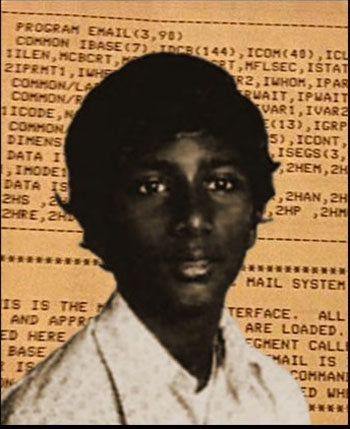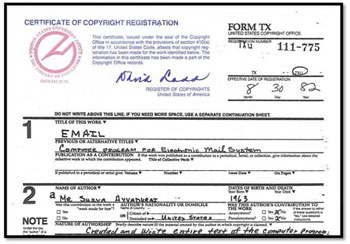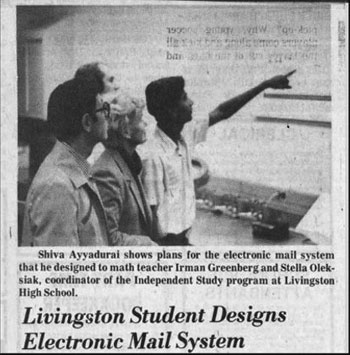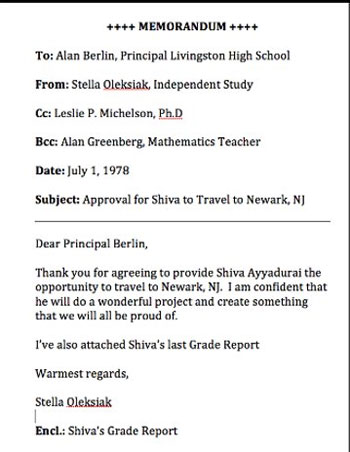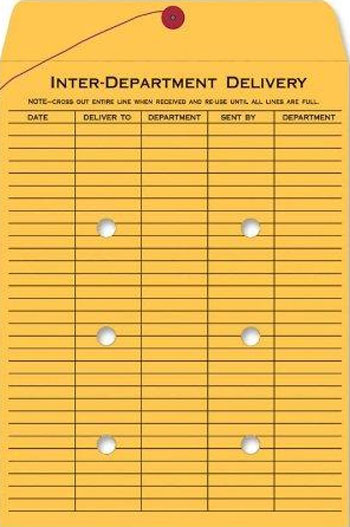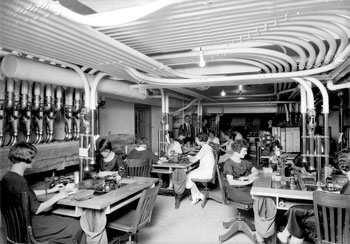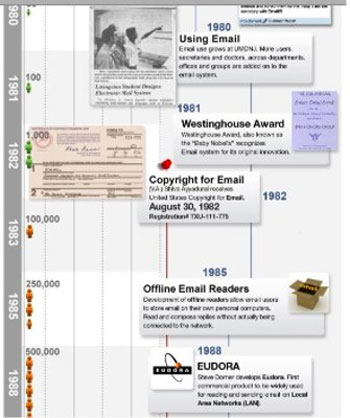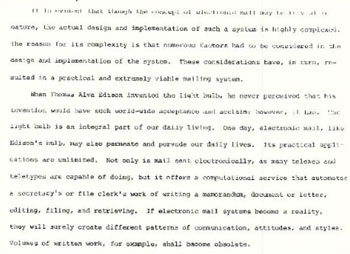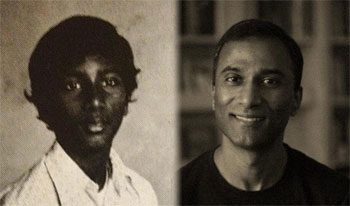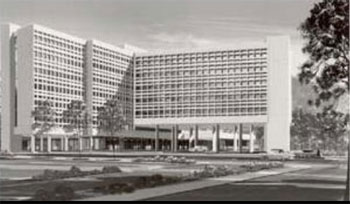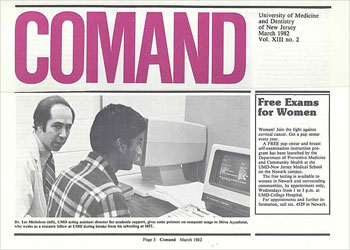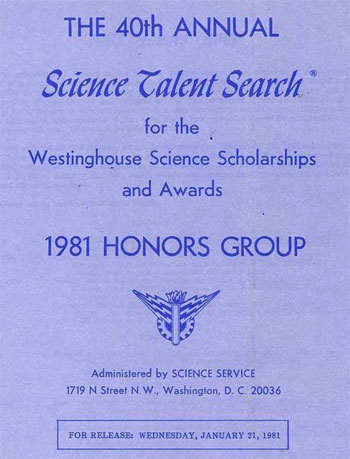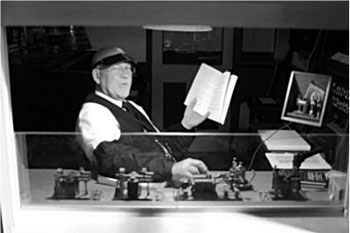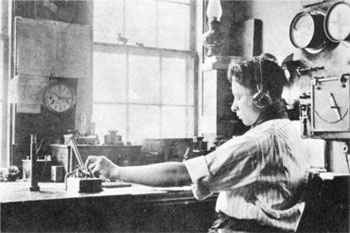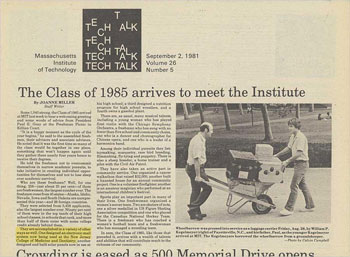Part 1 of 2
Origin of Email & Misuses of the Term “Email”by Deborah J. Nightingale, Sen Song, Leslie P. Michelson, Robert Field
NOTICE: THIS WORK MAY BE PROTECTED BY COPYRIGHTYOU ARE REQUIRED TO READ
THE COPYRIGHT NOTICE AT THIS LINK BEFORE YOU READ THE FOLLOWING WORK, THAT IS AVAILABLE SOLELY FOR PRIVATE STUDY, SCHOLARSHIP OR RESEARCH PURSUANT TO 17 U.S.C. SECTION 107 AND 108. IN THE EVENT THAT THE LIBRARY DETERMINES THAT UNLAWFUL COPYING OF THIS WORK HAS OCCURRED, THE LIBRARY HAS THE RIGHT TO BLOCK THE I.P. ADDRESS AT WHICH THE UNLAWFUL COPYING APPEARED TO HAVE OCCURRED. THANK YOU FOR RESPECTING THE RIGHTS OF COPYRIGHT OWNERS.
[Abstract: The origin of email, the
system as we all know and use today, begins in 1978 when a 14-year-old Research Fellow, V.A. Shiva Ayyadurai, working at the University of Medicine and Dentistry of New Jersey (UMDNJ), located in Newark, New Jersey, invented the first electronic system to replicate the interoffice, inter-organizational paper-based mail system consisting of Inbox, Outbox, Folders, Memo, Attachment, Address Book, etc. Ayyadurai named this system “email,” a term he was the first to create, because he was inventing the “electronic” or “e” version of the interoffice, inter-organizational paper-based “mail” system. Moreover, the specific naming of email arose for idiosyncratic reasons since FORTRAN IV, the programming language used to create his invention, required all variable and program names to be in upper case and a maximum of six characters, while the Hewlett Packard RTE-IVB operating system, on which the software executed, had a five-character limit for program names. These constraints motivated the selection of “E,” “M,” “A,” “I,” and “L.” Prior to 1978, neither the term “email,” in any variation, upper case, lower case, mixed case, with or without the dash, nor did the software application “email” exist. After Ayyadurai’s invention, the term “email” was misused, primarily by members of the ARPANET community and Raytheon/BBN, to refer to their developments in rudimentary methods for exchanging text messages, done
prior to 1978, as “email.” Such developments, while important in their own right, were not email, the system of interlocking parts intended to emulate the interoffice, inter-organizational paper-based mail system -- the email we all experience today.]
Contents:• 1 Introduction (Deborah J. Nighingale, Sen Song, Leslie P. Michelson, Robert Field)
• 2 The Invention of Email in Newark, NJ (1978)
• 3 V.A. Shiva Ayyadurai: The Inventor of Email
• 4 Email Is Not the Simple Exchange of Text Messages
• 5 Historical Revisionism of Email’s Origin
• 6 Misuses of the Term “Email”
o 6.1 Misuse #1: “Email” was created on the ARPANET
o 6.2 Misuse #2: Ray Tomlinson Invented “Email” and Sent the First “Email” Message
o 6.3 Misuse #3: The Use of the “@” Symbol Equals the Invention of “Email”
o 6.4 Misuse #4: RFCs Demonstrate “Email” Existed Prior To 1978
o 6.5 Misuse #5: Programs For Exchanging Messages Were “Email”
o 6.6 Misuse #6: Mail On CTSS Developed In 1960's Was “Email”
o 6.7 Misuse #7: In 2012, the Term “Email” Now Needs To Be Defined 6.8 Misuse #8: “Email” Is Not An Invention, But VisiCalc Is An Invention
o 6.9 Misuse #9: Dec And Wang Created “Email”
o 6.10 Misuse #10: Laurel Was “Email”
o 6.11 Misuse #11: The Term “Email” Belongs To Compuserve
o 6.12 Misuse #12: “Email” Has No Single Inventor
• 7 References
Chapter 1: Introduction“Email, upper case, lower case, any case, is the electronic version of the interoffice, inter-organizational mail system, the email we all experience today — and email was invented in 1978 by a 14-year-old working in Newark, NJ. The facts are indisputable.” (Garling, 2012)
-- Professor Noam Chomsky, MIT, Institute Professor & Professor of Linguistics
What is email? Email is actually a system --- a system of interlocking parts intended to emulate the interoffice, inter-organizational paper-based mail system consisting of the Inbox, Outbox, Drafts, Folders, Memo, Attachment, Address Book, etc., the now-familiar components of every email system (Pearl, 1993; Ramey, 1993; Markus, 1994; Tsuei, 2003), made accessible and easy-to-use for ordinary people with little to no computer experience to manage the complex and myriad functions necessary for office communications
mediated through the model of the interoffice memorandum (Yates & Orlikowski, 1992; Foster, 1994; Holmes, 1995; Morrisett, 1996).

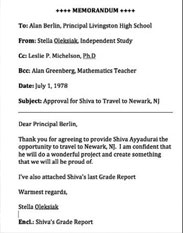
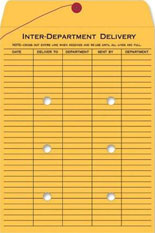
(a) (b) (c)
Fig. 1. The interoffice, inter-organizational paper-based mail system was managed by office workers who on their desktop (a) used a typewriter, an Inbox to receive mail, an Outbox for outgoing mail, a Drafts box for work in progress, file Folders for storage, etc. to compose and manage the (b) the Memorandum (memo), consisting of the “To:,” “From:,” “Cc:,” “Bcc:,” “Date:,” “Subject:,” the Body, and Attachments, which were placed in an Inter-Office Mail envelope (c) for distribution and delivery across offices and organizations.The interoffice, inter-organizational paper-based mail system, as shown in Figure 1, consisted of the office worker, who created the Memorandum or the memo (“To:,” “From:,” “Cc:,” “Bcc:,” “Date:,” “Subject:,” the Body, and Attachments), and used the interoffice mail envelope to transport the memo to a desired location. Transport of the envelope was done by workers who delivered it by foot, by automobile, and, at times, by an interconnected system of pneumatic tubes, as shown in Figure 2. This paper-based mail system, primarily used during the 1900s, and still used today in some organizations, was the central system of interoffice and inter-organizational paper-based communications from business owners to prime ministers and presidents.
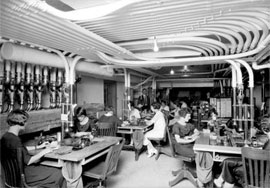
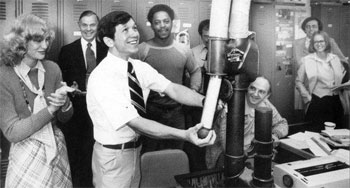
(a) (b)
Fig. 2. Office workers (a) were critical to the functioning of the interoffice, inter-organizational paper-based mail system; at times, an interconnected system of pneumatic tubes (b) were used to transport mail across offices and organizations.In 1978, V.A. Shiva Ayyadurai, a 14-year-old prodigy, who was accepted into a special program in computer science at the Courant Institute of Mathematical Sciences in New York University (NYU) (Mullish, 1978), was hired by Dr. Leslie P. Michelson, initially as a research scholar and later as a Research Fellow, at the University of Medicine and Dentistry of New Jersey (UMDNJ), located in Newark, New Jersey (Michelson, 2012). Michelson challenged Ayyadurai to create a software application, which would be full-scale electronic version (or emulation) to support all functions of the interoffice, inter-organizational paper-based mail system (Aamoth, 2012; Nanos, 2013; Gopalakrishnan, 2014), Table 1.
Prior to 1978, experts in the ARPANET community had concluded it “impossible” to invent such a full-scale electronic emulation of the interoffice, interorganizational paper-based mail system, as documented in the RAND Report published on December 1977 by Mr. David Crocker, a leading member of the ARPANET community (Crocker, 1977; Nightingale, 2014). Mr. Crocker unequivocally conveyed both the ARPANET researchers’ lack of interest as well as their conclusion to the
impossibility of creating such a system in the introductory sections of the Report, which defined the limits and scope of the ARPANET’s then-current work in electronic messaging:
"At this time, no attempt is being made to emulate a full-scale, inter-organizational mail system [p.4]…. The fact that the system is intended for use in various organizational contexts and by users of differing expertise makes it almost impossible to build a system which responds to all users' needs [p.7].” (Crocker, 1977)
-- Mr. David Crocker ARPANET Researcher, December 1977
In the 1970s, access to and use of computers were nearly exclusive to highly trained technical personnel such as systems analysts, programmers, scientists and engineers. More importantly, at the time, human interaction with computers required significant technical training that demanded the end user to have knowledge of computer programming languages and cryptic computer codes, making the use of the computer inaccessible to an ordinary person.
In this context, one can understand why the idea of an ordinary office worker, a “secretary,” primarily a woman, who was relegated to a typewriter at an office desk, and who likely had never even seen a computer, interacting with one, was thought inconceivable. In addition to overcoming such sociological barriers, “to build a system” that not only incorporated the myriad technological functions of the interoffice, inter-organizational paper-based mail system, as listed in Table 1, but also was designed easy-to-use for “users of differing expertise” from the secretary to the highly trained technical personnel was considered monumental, as reflected in Mr. Crocker’s statement.
Chapter 2: The Invention of Email in Newark, NJ (1978) The 14-year-old Ayyadurai, however, did not think it impossible to create such a system. He took on Michelson’s challenge (“Livingston Student”, 1980; Michelson, Bodow, Brezenhoff & Field, 2013), and did “attempt” to create such a system, and did do the “impossible,” when he became the first to conceive, design and invent the first software application that replicated myriad functions, as itemized in Table 1, of the interoffice, inter-organizational paper-based mail system (McLeod & Bender, 1982) so it could be of “use in various organizational contexts” and by “users of differing expertise” ranging from secretaries, office workers, students, doctors, who had never experienced a computer keyboard or terminal, to highly trained technical personnel such as systems analysts, programmers, scientists and engineers, i.e. end users (Cheney & Lyons, 1980; Michelson, et al., 2015).
Ayyadurai named his invention “email” (Smithsonian National Museum of American History [NMAH], 2012; Ayyadurai, 1982a; Ayyadurai, 1982b), a term he was the first to create in 1978, as verified by its first use in naming the main subroutine of his program (Smithsonian National Museum of American History [NMAH], 2012; Ayyadurai, 1982a; Ayyadurai, 1982b), as shown in Figure 3. The non-existence of the term “email,” prior to Ayyadurai’s creation of this term in 1978, is further substantiated by two eminent dictionaries the Oxford English Dictionary (“E-Mail Origin”, 1980) and the Merriam Webster Dictionary (“E-mail; First Known Use”, 1982) by their reference to the dates of origin of the term “email” and its variations, as being after 1978, in 1980 and 1982, respectively.
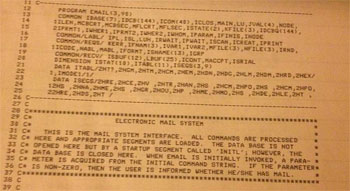 Fig. 3. The naming of “email” (c. 1978). (Smithsonian National Museum of American History [NMAH], 2012; Ayyadurai, 1982a; Ayyadurai, 1982b)
Fig. 3. The naming of “email” (c. 1978). (Smithsonian National Museum of American History [NMAH], 2012; Ayyadurai, 1982a; Ayyadurai, 1982b)Ayyadurai named the system “email” because he was inventing the “electronic” or “e” version of the interoffice “mail” system. Moreover, the specific naming of “email” arose from idiosyncratic reasons since the FORTRAN IV programming language, used to build the software, required all variable and program names to be in upper case and a maximum of six characters, while the Hewlett Packard RTE-IVB operating system, on which the software executed, had a five-character limit for program names. These constraints motivated the selection of “E,” “M,” “A,” “I,” and “L.
Chapter 3: V.A. Shiva Ayyadurai: The Inventor of EmailOn August 30, 1982, the United States government awarded Ayyadurai the first U.S. Copyright for “Email,” “Computer Program for Electronic Mail System” (Ayyadurai, 1982a), officially recognizing Ayyadurai as the inventor of email --- the system of interlocking parts designed to electronically emulate and expand the functionality of the interoffice, inter-organizational paper-based mail system.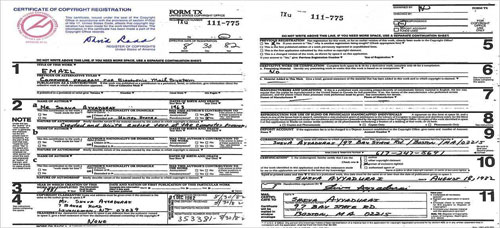 Fig. 4. The U.S. Government Copyright Issuance for “Email” in 1982, Officially Recognizing Ayyadurai as the Inventor of Email. (Ayyadurai, 1982a).
Fig. 4. The U.S. Government Copyright Issuance for “Email” in 1982, Officially Recognizing Ayyadurai as the Inventor of Email. (Ayyadurai, 1982a).At time of the invention of email
in 1978, there existed no legal methods to protect software inventions. In fact, software patents were non-existent, and questionable at best, since the patentability of software itself was unclear and not recognized by the United States Supreme Court (Flewellen, 1980; Moran and James, 1980). However, in 1980, the United States Copyright Act of 1976 was amended to include software inventions. This resulted in the United States Computer Software Act of 1980 (Crews, 1987; Lemley, et. al., 2006).
In 1981, Ayyadurai, per the compliance requirements of the new Computer Software Act of 1980, applied for legal protection of his invention. In 1982, he received such protection from the United States government, which formalized in government records his being the inventor of email. In addition to being awarded the Copyright for the software “Email,” Ayyadurai was also awarded another Copyright for the software users manual, “Email User’s Manual,” “Operating Manual for Electronic Mail System Program” (Ayyadurai, 1982b). The user’s manual provided the office workers at UMDNJ a detailed guide on how to use email.Ayyadurai’s distinction as the inventor of email, therefore, emerges from: 1) He being the first to conceive, design and invent the electronic version of the interoffice, inter-organizational paper-based mail system, containing all the features we experience today in every email program, which experts of the ARPANET community had deemed “impossible”; 2) His creating the term “email” in 1978 to name this invention; and, 3) His receiving formal legal protection and recognition by the United States government as the inventor of email.
The 14-year-old Indian immigrant’s invention, moreover, was likely the world’s first end user software application that made the computer accessible and meaningful to the lives of ordinary people. Ayyadurai’s invention was revolutionary not only for the technological and design challenges that it overcame but also for the sociological and elitist barriers that it broke by enabling ordinary office workers, primarily woman, to move from the typewriter and paper to the terminal and keyboard, where email became their gateway to the brave new world of computing and digital communications.What is even more compelling is the prescience of the young teenage inventor as to the relevance of his own invention, and its potential to humankind. In 1981, he submitted an essay on his invention for an awards entry to the Thomas Alva Edison/Max McGraw Foundation to be considered for a scholarship to support his attending university (Ayyadurai, 1981). The concluding paragraph in Ayyadurai’s essay reveals that prescience:
“[Email]’s practical applications are unlimited. Not only is mail sent electronically, as many telexes and teletypes are capable of doing, but it offers a computational service that automates a secretary’s or file clerk’s work of writing a memorandum, document or letter, editing, filing, and retrieving. If electronic mail systems become a reality, they will surely create different patterns of communication, attitudes, and styles. Volumes of written work, for example, shall become obsolete.” (Ayyadurai, 1981)
-- V.A. Shiva Ayyadurai in 1981, Livingston High School Thomas Alva Edison/Max McGraw Awards Application
His invention did not go unnoticed and began to receive public recognition starting as early as 1980. On October 30, 1980, for example,
a feature article, with the headline “Livingston Student Designs Electronic Mail System,” appeared in the West Essex Tribune, which described his development efforts while a high school student involved in a special independent study program setup by a pioneering Livingston High School educator, Ms. Stella Oleksiak (“Livingston Student”, 1980).
On January 21, 1981, the prestigious Westinghouse Science Talent Search Awards, today known as the Intel Science Talent Search Awards, honored his invention by awarding him the prestigious Westinghouse Science Talent Search Honors Group Award (Westinghouse, 1981).
On September 2, 1981, the Massachusetts Institute of Technology (MIT), the most eminent science and technology institute in the world, also found it important to mention and recognize the invention. On that day, Ayyadurai was attending MIT’s incoming freshman student orientation for the Class of 1985.
The front page of the MIT Tech Talk, the official newspaper of the MIT faculty and administration, highlighted achievements of only 3 of the 1,041 students entering the MIT Class of 1985. Ayyadurai was one of them. The article shared his invention of email (Miller, 1981).
Chapter 4: Email Is Not the Simple Exchange of Text MessagesAfter Ayyadurai’s invention, the term “email” began to be used to refer to methods for the simple exchange of text messages, done prior to 1978. However, email is not simply a method for the rudimentary exchange of text messages (Ngwenyama & Lee, 1997), as some have erroneously documented (Marold & Larsen, 1997), and one which continues to appear even on popular websites such as Wikipedia, which define “email” as “a method of exchanging digital messages” (“Email”, n.d., para 1)
In the 1970s and early 1980s, developing such methods for the simple exchange of text messages was the focus of early workers at the Defense Advanced Research Projects Agency (DARPA) and its ARPANET research community, Raytheon/Bolt Beranek and Newman (BBN), and MIT, in order to support military battlefield communications (Kuo, 1979; Lyons, 1980; Postel, Sunshine & Cohen, 1981). The aim of their efforts was to develop methods for the reliable communication of simple text messages from one location to another (Cerf, 1979; Malgieri, 1981).
The invention of email by Ayyadurai at UMDNJ in Newark, New Jersey, in contrast, was not motivated to create such simple point-to-point exchange of text messages for supporting battlefield communications, but rather to create a system to manage the complex functions of day-to-day civilian office communications where the interoffice memo was the primary medium of formal business communications in the office environment (Yates, 1989; Gains, 1999; Orlikowski & Yates, 1994).
The military had little interest in creating a system for managing the interoffice memorandum on the battlefield. This was far beyond their scope of work as the ARPANET was neither designed nor intent on creating email (Patel, 2003). The ARPANET researchers were not being funded by the military to make the lives of ordinary office workers easy.
Even as late as 1985, seven years after the invention of email by Ayyadurai in Newark, NJ, the ARPANET’s official brochure, ARPANET Information Brochure (Dennett, Feinler & Perillo, 1985), Figure 5a, makes no mention whatsoever either about “email” or “electronic mail” as evidenced by the lack of existence of any entries in its Index, Figure 5b, starting with “e,” for “email” to be found anywhere in the Index of this brochure.
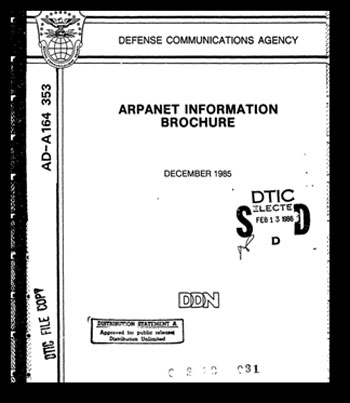
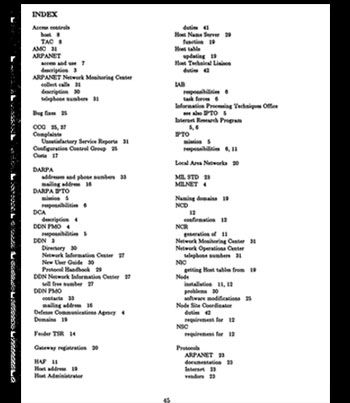
(a) (b)
Fig. 5. The ARPANET’s ARPANET Information Brochure cover page (a), and the Index on page 45 (b), which makes no mention or use of “email.”Chapter 5: Historical Revisionism of Email’s OriginThe historical revisionism to re-define the term “email” as the simple exchange of text messages took place after Ayyadurai’s invention so as to misappropriate credit specifically to DARPA, the ARPANET researchers, MIT and Raytheon/ BBN. Following Ayyadurai’s invention of email, Raytheon/BBN, a multibillion dollar defense contractor, created its entire brand image as the “inventor of email,” to provide itself a competitive advantage in the lucrative cyber-security market (Raytheon/BBN. (n.d.). The ARPANET community, including personnel such as Mr. Crocker, now misuse the term “email” to perpetuate the claim that the ARPANET created “email” to perpetuate a false narrative that all great innovations, such as email, only emerge in a “collaboration”(Crocker, 2012) from the realms of the military-industrial-academic complex (Leydesdorff & Etzkowitz, 1996; Etzkowitz & Leydesdorff, 2000; Carayannis & Campbell, 2011).
The misuses of the term “email” not only attempts to misappropriate credit when the ARPANET community had no intention to create email as they had thought it “impossible,” but also attempts to confuse journalists by equating “email” to be the simple exchanges of text messages so as to obfuscate email’s true origin, away from the monumental achievement of a 14-year-old boy, working in Newark, New Jersey, in 1978. This manuscript itemizes and exposes these misuses, many of which are deliberately perpetuated by a cabal of “historians,” who promote this false narrative as their allegiance, in spite of the overwhelming and overt facts, is to the larger narrative that great innovations, such as email, can only emerge from the military-industrial-academic complex (‘SIGCIS Blog’, 2012).
The facts are that in 1978, at UMDNJ in Newark, New Jersey, there was no ARPANET, and the invention of email did not depend on any infrastructure or technology created by the ARPANET. The challenge to invent email required Ayyadurai to go far beyond just creating a simple means to exchange text messages. He used a computer network that was already present at UMDNJ and independent of the ARPANET. The challenge demanded him to invent an entire communications platform consisting of a sophisticated database and workflow systems architecture, while implementing the myriad features for enabling interoffice, interorganizational paper-based mail communications (Smith, 2011; Gopalakrishnan, 2014) necessary for office workers to move from the world of the typewriter to the realm of the keyboard and computer terminal, delivered through an easy-to-use interface. Ayyadurai’s work was focused on digitizing the entire “system” of interoffice communications rather than just the mere transport of messages reliably from point-to-point (Westinghouse, 1981; Field, 2014).
The components used by Ayyadurai to build email, furthermore, were not based on any tools or technologies built by DARPA or the ARPANET community. The tools used by Ayyadurai to build email were: 1) computer hardware, 2) an operating system, 3) terminals and keyboard, 4) a network, 5) a programming language, and 6) a database system (Michelson, 2012; Field, 2014). These components already existed at UMDNJ in 1978, and none of them were developed by the ARPANET. Erroneous claims promulgated by some “historians,” and copy and pasted in tabloid journals and blogs have asserted that the components used by Ayyadurai to invent email at UMDNJ had been created previously by the ARPANET (Biddle, 2012; Aguilar, 2012). This is simply not true, but is duplicitous, and serves to perpetuate the false and revisionist history, going back to the 1970s, when Raytheon/BBN attempted to [take] credit for having “invented everything,” as noted by the Mr. M.A. Padlipsky, a computer scientist and contemporary of Mr. Crocker, who was also a prolific ARPANET contributor and author of more than 20 RFC specifications.Mr. Padlipsky, in a famous essay, shared how Raytheon/BBN was habitual in performing such historical revisionism to take credit “…for having invented everything…” (Padlipsky, 2000):
“[T]he[Raytheon/]BBN guys - who always seemed to get to write the histories and hence always seemed to have claimed to have invented everything, anyway, perhaps because BBN was the only "for-profit" to furnish key members of the original Network Working Group.”
-- Mr. M.A. Padlipsky, ARPANET Researcher
Ayyadurai, as a 14-year-old boy working in Newark, New Jersey, in contrast, sought neither fame nor fortune for his invention of email. His efforts were done independent of the ARPANET or Internet, and ran on its own private network known as the Laboratory Computer Network (LCN), which had been earlier implemented to connect the four campuses of UMDNJ (Michelson, 2014). Email did not need to “transport messages,” but provided a novel database-driven mechanism to share the interoffice memorandum across relevant users and organizational hierarchies, long before Simple Mail Transfer Protocol (SMTP) was made available in 1982 (Postel, 1982a) and which was four years after email’s invention at UMDNJ in 1978.
Therefore, the triangle of DARPA (including the ARPANET community), Raytheon/ BBN and MIT, simply put, cannot take credit for email’s invention. They were solving a different, important, but much easier problem, from Ayyadurai’s mission to create email, the first full-scale electronic emulation of the entire interoffice, inter-organizational paper-based mail system. An objective review of these facts that email’s history begins from the civilian interoffice, inter-organizational paper-based mail communication system at UMDNJ in 1978 and not from the military or its developments prior to 1978 provides a much larger historical lesson that innovation can occur anytime, anyplace by anybody, outside of big universities, military and large corporations (Aamoth, 2013; Garling, 2012; Rocca, 2015).
Chapter 6: Misuses of the Term “Email”So email as a system is not simply exchanging messages among computers, even if a person at one end types a message to a human recipient.
Sending text messages alone is what today we call Texting, SMS, Chat or Twitter. Standard histories of the Internet are full of claims that certain individuals (and teams) in the ARPANET environment in the 1970s and 1980s ‘invented email’. For example, the ‘@’ sign, early programs for sending and receiving messages, and technical specifications known as RFCs, have been claimed to be ‘email’.
But as some claimants have admitted, none of these innovations were intended as a system of interlocking parts - Inbox, Memo, Outbox, Folders, Address Book, etc. - the email system used today by billions of people worldwide.These standard histories have misused the term “email” - which today is understood to be a system of interdependent features - to apply to other forms of electronic communications. Those developments aimed to solve various problems, but were not intended to substitute for the interoffice paper mail system.
On February 16, 2012, nearly 35 years after Ayyadurai’s invention of email, the Smithsonian Institution’s National Museum of American History (NMAH) acquired his papers, artifacts and computer code, documenting his invention in 1978 at UMDNJ. The Smithsonian acquisition led to a vocal minority unleashing disinformation to deny email’s origin in spite of the technical and legal documentation of facts.
These attacks were unwarranted and unfortunate and, as subsequent research revealed, the attacks were motivated by industry insiders intent on protecting the vested interests of Raytheon/BBN, a multi-billion dollar company, which, during the period after Ayyadurai’s invention of email in 1978, had built its entire brand on the falsehood that it had “invented email.” Some detractors went so far as to confuse the public by stating that upper case “EMAIL,” was different than lower case “email,” to misappropriate credit away from Ayyadurai.The eminent linguist Professor Noam Chomsky, during the heated controversy in 2012, responded by stating (Garling, 2012):
“What continue[s] to be deplorable are the childish tantrums of industry insiders who now believe that by creating confusion on the case of ‘email,’ they can distract attention from the facts….Given the term email was not used prior to 1978, and there was no intention to emulate ‘…a full-scale, inter-organizational mail system,” as late as December 1977, there is no controversy here, except the one created by industry insiders, who have a vested interest.”
-- Professor Noam Chomsky, MIT, Institute Professor & Professor of Linguistics
These vested interests included a coterie of “historians,” who instigated the harsh vitriol against Ayyadurai in order to deliberately discredit and character assassinate Ayyadurai to distract media and press from the indisputable facts of email’s origin, by spreading disinformation and false claims about email’s origin. Twelve of these false claims, originally itemized, investigated and exposed as disinformation by Drs. Nightingale and Song (Nightingale and Song, 2012) have now been compiled and updated in the
Supplementary Materials of this manuscript, to demonstrate how misuses of the term “email” were used to disseminate fiction versus fact on the origin of email. These claims include:
1. “Email” was created on the ARPANET.
2. Ray Tomlinson invented “email” and sent the first “email” message.
3. The use of the “@” symbol equals the invention of “email.
4. RFCs demonstrate “email” existed prior to 1978.
5. Programs for exchanging messages were “email”.
6. Mail On CTSS developed in 1960's was “email”.
7. In 2012, the term “email” now needs to be defined.
8. “Email” is not an invention, but VisiCalc is an invention.
9. Dec and Wang created “email”.
10. Laurel was “email”.
11. The term “email” belongs to Compuserve.
12. “Email” has no single inventor.
The addendum elaborates on each instance and explains why they are misuses of the term “email” by providing references to primary sources that definitively expose that what is referred to as “email,” in such uses, was not email but rudimentary methods for text messaging. The research across hundreds of primary sources concerning these false claims shows that each of these innovations, while very important in the evolution of the Internet, were single functions and never email --- the system of interlocked components intended to emulate the interoffice, inter-organizational paper-based mail system.
6.1 Misuse #1: “Email” was created on the ARPANETThe statement:
“Under ARPANET several major innovations occurred: email (or electronic mail), the ability to send simple messages to another person across the network,” (Bellis, 2012)
misuses the term “email,” since the invention referenced as “email,” and attributed to the ARPANET, in the above statement is command-line protocols for transferring text messages, not email --- a system of interlocking parts designed to be fullscale emulation of the interoffice, inter-organizational paper-based mail system.
Early workers of the ARPANET community, such as Mr. David Crocker, in the field of electronic messaging, admitted, with great and direct clarity, that the ARPANET community, had no intention to create a full-scale electronic version of the interoffice or inter-organizational paper-based mail system. This is expressed in the following two statements of Mr. Crocker, published in December of 1977, months before Ayyadurai began his work in inventing email.
“At this time, no attempt is being made to emulate a full-scale, inter-organizational mail system. p.4” (Crocker, 1977)
“The level of the MS project effort has also had a major effect upon the system’s design. To construct a fully-detailed and monolithic message processing environment requires a much larger effort than has been possible with MS. In addition, the fact that the system is intended for use in various organizational contexts and by users of differing expertise makes it almost impossible to build a system which responds to all users’ needs. p.7” (Crocker, 1977)
Moreover, other electronic messaging workers of that same time, such as
Tom Van Vleck, affiliated with the ARPANET community, also admitted that their superiors, at the time of their work in electronic messaging, in the early 1970s, made it clear that they were not allowed to work on creating an electronic system to replicate “letters” e.g. the interoffice paper mail system, since it was considered a waste of time, as expressed in this statement:
“The idea of sending ‘letters’ using [the Compatible Time-Sharing System] was resisted by management, as a waste of resources.” (Van Vleck, 2001)
Mr. Van Vleck, one of the vocal detractors to the news of Ayyadurai’s invention of email in March 2012, after the Washington Post’s news of the February 16, 2012 Smithsonian’s acquisition of Ayyadurai’s documents, went to the extent of revising his own Multicians.Org history of email website, in March of 2012, which had remained unchanged for many years, by inserting the word “initially” to the sentence referenced above to read:
“The idea of initially sending ‘letters’ using [the Compatible Time-Sharing System] was resisted by management, as a waste of resources.” (Nightingale and Song, 2014b)
This revisionism was done deliberately to give the false impression that somehow, he was allowed, back in his time, by his “management” to implement the “letter”, or interoffice memo, afterwards following an “initial” resistance. Mr. Van Vleck made this revision to his website after the authors of this manuscript’s research team discovered and published Mr. Van Vleck’s original comment that he was not allowed to work on “letters.”By revising his own website, after our exposure of his lack of intent to invent anything close to email, Mr. Van Vleck was performing historical revisionism on his own material. The research team was fortunate, at the time, to capture in screenshots as shown in Figure 6, which documents this revisionism. Mr. Van Vleck’s historical revisionism was done retroactively to substantiate that he was allowed to work on an electronic system for “letters” so as to take credit for the invention of “email.”
BEFORE (a)
Note: Van Vleck clearly states that CTSS management resisted allowing him to create a system for sending "letters" e.g. To, From, Cc, Bcc, etc, but would allow him to create a system for sending/receiving, requests, e.g. text messages.
Here is the Original Text
"The Idea of sending 'letters' using CTSS was resisted by management, as a waste of resources. However, CTSS Operations did need a facility to inform users when a request to retrieve a file from tape had been completed, and we proposed MAIL as a solution for this need."
AFTER (b)
Note: Now, "initially" added -- subtle but a BIG difference.
Here is the Revised Text
"The Idea of sending 'letters' using CTSS was initially resisted by management, as a waste of resources. However, CTSS Operations did need a facility to inform users when a request to retrieve a file from tape had been completed, and we proposed MAIL as a solution for this need."
Fig. 6. Blatant example of historical revisionism conducted by Mr. Tom Van Vleck after hearing of Smithsonian’s acquisition of documents validating Ayyadurai’s invention of email at UMDNJ. Before the Smithsonian news of February 16, 2012, Mr. Van Vleck’s website had the content as shown in (a). After the Smithsonian news (c. March 2012), Mr. Van Vleck changed the content to as shown in (b). (Nightingale and Song, 2014b).This was not the only instance of this kind of revisionism that Mr. Van Vleck deliberately performed.
On another part of his website, again after the Smithsonian’s acquisition on February 16, 2012, Mr. Van Vleck revised his own published timeline of the history of email where in that timeline Mr. Van Vleck inserts that he invented email in 1965, as shown in Figure 7A and Figure 7B below (Nightingale and Song, 2014b)
BEFORE (a)
1971 Ray Tomlinson develops an email application for over the ARPAN ... message had been received Tomlinson chose the "@" sign for email ...
1970 - Monty Python Spam Skit airs
1960s Email developed for time share computers (individuals could me ...
1890s, USPS declared it illegal to deliver paper messages through pneu ...
AFTER (b)
1971 Ray Tomlinson develops an email application for over the ARPAN ... received Tomlinson chose the "@" sign for email addresses.
1970 - Monty Python Spam Skit airs
1965 Noel Morris and Tom Van Vleck invent email
1960s Email developed for time share computers (individuals could me ...
1890s, USPS declared it illegal to deliver paper messages through pneu ...
Fig. 7. Another blatant example of historical revisionism conducted by Mr. Tom Van Vleck after hearing of Smithsonian’s acquisition of documents validating Ayyadurai’s invention of email at UMDNJ. Before the Smithsonian news of February 16, 2012, Mr. Van Vleck’s website had the history of email timeline as shown in (a). After the Smithsonian news (c. March 2012), Mr. Van Vleck changed the content to as shown in (b). (Nightingale and Song, 2014b)6.2 Misuse #2: Ray Tomlinson Invented “Email” and Sent the First “Email” MessageThe statements such as these:
“Ray Tomlinson invented email in 1971.” ("Ask.com - What's Your Question?", 2012)
“Ray Tomlinson sent the first email.” (
"A Brief History of Email in the Federal Government.", 2012)
“Ray Tomlinson is credited with inventing email in 1972. Like many of the Internet inventors, Tomlinson worked for Bolt Beranek and Newman as an ARPANET contractor.” ("History of Internet/Email.", 2012)
misuse the term “email,” since Mr. Ray Tomlinson did not invent email --- the system of interlocking parts which is the full-scale emulation of the interoffice, inter-organizational paper-based mail system.
The invention referenced in these statement(s) and attributed to Tomlinson is the simple exchange of text messages between computers. Tomlinson simply modified a pre-existing program called SNDMSG, which he did not write, but made some minor modifications to, in order to enable the exchange of simple text messages across computers.
SNDMSG required a set of cryptic and highly technical computer codes to instruct the computer to transfer a message from one computer to another. Only trained technical personnel, such as computer scientists and technicians, not end users, such as a secretary or office worker with minimal to no computer knowledge, could use such a method. Tomlinson updated this previously existing SNDMSG command program to transmit text strings over a network connection. SNDMSG was not a system of interlocking parts designed for laypersons to manage routine office communications; thus, it was not designed to replicate the interoffice, inter-organizational paper-based mail system.
As primary references show, SNDMSG was not only not email but also was just a very rudimentary form of text messaging (Vittal, 1981):
“The very simple systems (SNDMSG, RD, and READMAIL) did not integrate the reading and creation functions, had different user interfaces, and did not provide sufficient functionality for simple message processing.” (Vittal, 1981)
Moreover, Tomlinson, to his own admission, said his work was a “no-brainer” and was merely a minor contribution (Tomlinson, 2012):
“I was making improvements to the local inter-user mail program called SNDMSG. The idea occurred to me that CPYNET could append material to a mailbox file just as readily as SNDMSG could. SNDMSG could easily incorporate the code from CPYNET and direct messages through a network connection to remote mailboxes in addition to appending messages to local mailbox files. The missing piece was that the experimental CPYNET protocol had no provision for appending to a file; it could just send and receive files. Adding the missing piece was a no-brainer—just a minor addition to the protocol.” (Tomlinson, 2012).
Tomlinson’s work was in no manner comparable to the enterprise-class system that Ayyadurai developed at UMDNJ, that was a complete end user application consisting of 50,000 lines of code, built from the ground up, to create email --- the full-scale emulation of the entire interoffice, inter-organizational paper-based mail system in 1978.What is also alarming, in this context, is that Michael Padlipsky's famous essay, originally linked on Van Vleck’s site, in which Padlipsky exposed Tomlinson’s conflated claim as being the “inventor of email,” (Padlipsky, 2000):
“I don't believe Ray Tomlinson invented ‘e-mail.’ And not because of the quibble that we called it netmail originally, though that does offer an excuse to observe that I personally find the term ‘e-mail’ awfully cutesy, and references to ‘sending an e-mail’ syntactic slime. Nor because of the semi-quibble that ‘mail’ had been around intra-Host on several of the Host operating systems since well before anybody realized they were Hosts, though that one has a great deal of abstract ‘historical’ appeal. No, it's because I have a completely clear memory that Ray wasn't even at the FTP meeting where we decided to add mail to the protocol.” (Padlipsky, 2000)
was deleted and removed by Van Vleck (Nightingale & Song 2014b), after the Smithsonian event. Van Vleck’s website used to link to Padlipsky’s article prior to the Smithsonian event.
Prior to the Smithsonian event, Van Vleck also questioned the claim that Tomlinson was the “inventor of email,”; however, after the Smithsonian event, Van Vleck, who by all indications had close and collegial relationships with members of the ARPANET community who were threatened by Ayyadurai’s facts exposing their false claims, changed his sardonic position of Mr. Tomlinson being the “inventor of email,” fell in line with the revised propaganda of Raytheon/BBN, after the Smithsonian event, to deem Tomlinson as the inventor of “network email,” a new term crafted to bequeath credit to the ARPANET community in the face of the mounting facts, following Ayyadurai’s documentation of inventing email in 1978.6.3 Misuse #3: The Use of the “@” Symbol Equals the Invention of “Email”The statement:
“When [Tomlinson] is remembered at all, it is as the man who picked ‘@’ as the locator symbol in electronic addresses. In truth though, he is the inventor of e-mail, the application that launched the digital information revolution. And yet the breakthrough he made was such a simple evolutionary step that hardly anyone noticed it till later.” (“The Invention of Email,” 1998)
misuses the term “email” since it implies that Ray Tomlinson’s use of the “@” symbol is equivalent to inventing email -- the system of interlocking parts which is the full-scale emulation of the interoffice, inter-organizational paper-based mail system.
The “@” symbol is used to separate the user name from the domain name. The invention referenced in the above statement is the use of the “@” symbol to distinguish two computers when sending a text message. The “@” symbol is not a necessary component of email -- the system of interlocking parts. In some cases “-at” was used (Van Vleck, 2012), or the “.” symbol as in the first email system developed by Ayyadurai.
“Because the ‘@’ was a line kill character in Multics, sending mail from Multics to other hosts used the control argument -at instead.” (Van Vleck, 2012)
Some have mistakenly characterized the “@” symbol as something very unique, “underused” and novel. As a point of fact, the “@” symbol was the linekill character on Multics, (Pogran, 2012), another early timesharing system, and created a character conflict for those Multics users trying to use Tomlinson's SNDMSG.
As Kenneth Pogran recalled:
“Do folks remember that ‘@’ was the Multics line-kill character? We were opposed to Ray Tomlinson's famous (or is it infamous?) selection of @ as the character that separated the user name from the host name…. Early versions … allowed the use of space-a-t-space (i.e., ‘at’) in place of the ‘@’ to accommodate Multics (and the mail composition software I wrote used the syntax -at on the command line)” (Pogran, 2012).
“Early versions of ARPANET email specs allowed the use of space-a-t-space (i.e., " at ") in place of the ‘@’ to accommodate Multics and the mail composition software I wrote used the syntax -at on the command line to begin composing an email….” (Pogran, 2012)
The “@” symbol was “underused” only to the extent that it interfered with some users' host environments. Equating of the “@” symbol with the invention of email was a result of the branding and marketing effort of Raytheon/BBN as obvious on their web site in 2012. After the Smithsonian’s acquisition of Ayyadurai’s documents, which began to expose the false claims of Raytheon/BBN (Padlipsky, 2000), Raytheon/BBN escalated their PR and marketing efforts as documented on the history of email section on
http://www.inventorofemail.com. Raytheon/BBN, in fact, cleverly juxtaposed the “@” symbol with Tomlinson as their brand mascot, with the false claim that he “invented email”.
6.4 Misuse #4: RFCs Demonstrate “Email” Existed Prior To 1978The statement:
“…email underpinnings were further cemented in 1977's RFC 733, a foundational document of what became the Internet itself.” (Biddle 2012)
misuses the term “email” since
Requests for Comments (RFCs) were simply written documentation, not a computer program, nor software, nor email ---- the system of interlocking parts which is the full-scale emulation of the interoffice, interorganizational paper-based mail system.
RFCs were literally meeting notes following meetings by electronic messaging researchers. RFCs, such as RFC 733, were written documentation not a computer program or code or system. Moreover, statements such as, and others like it:
“In 1977 these features and others went from best practices to a binding standard in RFC 733.” (Biddle, 2012)
are hyperboles and conflation of RFCs.
Mr. Sam Biddle, neither a computer scientist nor a software developer, who wrote the statement referenced above, in an article in Gizmodo referencing Ayyadurai as an “asshole” and “dick,” is known for his puerile, sensationalist, and yellow journalism. For example, a few weeks after writing this outrageous article on Ayyadurai, Biddle wrote an article about a virtual Internet dog name “Boo,” which had died. It was later found out that “Boo” had not died. Anderson Cooper, a CNN journalist, later exposed Mr. Biddle’s quality of journalism on his TV news show “The Ridiculist.”What is unfortunate is that even scholarly “historians,” like Mr. Thomas Haigh, a leader of the SIGCIS group, and others either purposely wanting to deny the facts of email’s origin from 1978 at UMDNJ, or unconsciously cutting and copying the Gizmodo article, believing Biddle’s sensationalistic article to be the truth, continue to use Biddle’s article as a primary and scholarly source reference to deny email’s invention by Ayyadurai in Newark, New Jersey. Such tabloid articles are referenced as the primary source on Wikipedia and some major media to attempt to perpetuate false assertions that RFCs are email, and predate Ayyadurai’s invention.Specifically, RFC 733, for example, is a document that was drafted in November 1977, and was simply, at best, a specification attempting to provide a standardization of messaging protocols and interfaces. RFC 733 should not be conflated as “email underpinnings” (Biddle, 2012) and equated as email --- the electronic system of interlocking parts emulating the interoffice, inter-organizational paperbased mail system created by Ayyadurai at UMDNJ in 1978.The RFC 733 is explicitly described as:
"This specification is intended strictly as a definition of what is to be passed between hosts on the ARPANET. It is NOT intended to dictate either features which systems on the Network are expected to support, or user interfaces to message creating or reading programs."
RFC 733 did not even dictate which features of the interoffice, interorganizational paper-based mail process would be included, such as the basic components of the user interfaces for message creation and reading. Moreover, RFC 733 attempted to define a standard that was never even fully accepted nor implemented. (Crocker et al., 1977).
“Some of RFC #733's features failed to gain adequate acceptance.” (Crocker et al., 1977)
The very term “RFC” means “Request for Comments” and were typically lists, notes and at best specifications (Shicker, 1981) on what could be in the future, but were neither computer code nor software application, such as email, the system and software application developed by Ayyadurai.
“Prospective users, system designers, and service offering companies often compile lists of potential services [of electronic mail systems]… Nobody claims that these lists are complete, and most often it is admitted freely that these lists represent a first cut synthesis of services offered by other communication facilities. Unfortunately, these lists mostly convey just a number of buzz-words which everybody interprets in his own fashion.” (Shicker, 1981)
In summary, RFCs only proposed an interface for message format and transmission, but said little about feature sets of individual electronic messaging or mail systems. The RFCs’ authors, by their own admission, clearly state this was not their intention. RFCs were the definition of command-line terminology, at best, but certainly not email --- the system of interlocking parts intended to emulate the interoffice, inter-organizational paper-based mail system.6.5 Misuse #5: Programs For Exchanging Messages Were “Email”The statement:
“By the mid-1970s, other user-oriented e-mail programs arrived on the scene. Two of the more popular examples were ‘Hermes’ at Bolt, Beranek, and Newman, now BBN—a wholly owned subsidiary of Raytheon — and ‘Laurel,’ which was in use at Xerox PARC.” (Crocker, 2012)
misuses the term “email” since programs like Hermes and Laurel were not email - -- the system of interlocking parts which is the full-scale emulation of the interoffice, inter-organizational paper-based mail system. Laurel was really, in fact, a single component, front-end for the independent, lower-level Grapevine messaging platform (Schroeder, 1984).“A client program of Grapevine generally obtains services through code…. The primary clients of Grapevine are various mail interface programs, of which Laurel is most widely used.” (Schroeder, 1984)
Though Laurel was beginning to incorporate some elements of the interlocked parts such as folders and the inbox, it was still like nearly all messaging systems of the period: heavily dependent on external system resources, and not designed as a system of interlocking parts to be a full-scale emulation of the interoffice, interorganizational paper-based mail system.
Furthermore, internal Xerox documentation (Schroeder, 1984), such as:
“…the Grapevine system was first made available to a limited number of clients during 1980.” (Birrel, 1980)
shows that
independent Grapevine component was still being prototyped with five dedicated servers in 1981, well after Ayyadurai’s invention of email (from 1978) which had been in use in routine communications at UMDNJ for several years by 1980. No word of Laurel or Grapevine, moreover, is publicly available until 1982 (Tesler, 2012). Larry Tesler, who worked at Xerox during 1973 to 1980 on the internal development of Laurel, acknowledges that he himself did not
“… know what if any email systems based on unofficial internet standards were implemented before 1979.” (Tesler 2012)
Tesler, however, was aware that Laurel was still under development in 1979 (Tesler, 2012), when the Xerox work would be published in the Communications of the ACM (Schroeder, 1984, Birrell, 1980).
Hermes was similar. It was not a system of interlocked parts and not something user-friendly that an ordinary office worker could use. Users had to learn about twenty commands to use it (Vallee, 1984):
“In systems like SEND MESSAGE and its successors, such as HERMES, ON-TYME, and COMET, there is no provision for immediate response. A message is sent into a mailbox for later access by the recipient. No automatic filing is provided: any searching of message files requires users to write their own search programs, and to flag those messages they want to retain or erase. The burden is placed on users to manage their own files, and a fairly detailed understanding of programming and file structures is required. Both senders and receivers must learn about 20 commands, and if they misuse them they can jeopardize the entire data structure. Some messages may even be lost in the process.” (Vallee, 1984)
Another program, PLATO, which was an invention for computer-assisted instruction, which some reference as “email,” also is best understood from Vallee’s comments, which also help to place in context PLATO relative to Ayyadurai’s invention (Vallee, 1984).
In 1979, all known messaging systems were itemized in RFC 808 by the leading researchers who worked at the big universities, large companies and for the military (Postel, 1982b):“Dave Farber gave a bit of history of mail systems listing names of all the systems that anybody had ever heard of (see Appendix A)…. It was noted that most of the mail systems were not formal projects (in the sense of explicitly sponsored research), but things that ‘just happened’.” (Postel, 1982b)
Note, Laurel and PLATO do not appear on this list in Postel’s “Appendix A” as late as 1982.For a review of individual systems of the period, it is best to look at the 1979 RFC (‘IETF Tools’, 2012), which contains a listing of the names of all the computer mail systems anybody had ever heard of, at the time. The vast majority of the systems, itemized in this list, such as MSG, MS, SNDMSG, RD, and HERMES, all share a common ancestry, and inherit features (and deficiencies) from this heritage. John Vittal tried to distinguish the features and qualities of his MSG message system relative to its antecedents (Vittal, 1981):
MSG started from a set of primitive message processing operations. Several of the commands listed above were not implemented in the initial version of MSG:
Creation: Answer and Forward
Motion: Move
File operations: Write
Marking: Mark and Unmark
User-interface and Profile: Koncise, Verbose, and Zap profile
Miscellaneous: Print date and Comment
It became clear, even before MSG was first publicly released, that the operations of Put and Delete were so commonly used together that a combining operation (Move) should be included in the functionality of the system. This was the first major modification.
COMPARISON WITH OTHER SYSTEMS
Many of the other CBMSs of the time have already been alluded to. The very simple systems (SNDMSG, RD and READMAIL) did not integrate the reading and creation functions, had different user-interfaces, and did not provide sufficient functionality for simple message processing.
On the other hand, two systems came very close to MSG. BANANARD gained acceptance, but seemed to not have the right functionality. The user-interface seemed to be a little too verbose for experienced users. However, it is important to note that some users still prefer to use BANANARD. These tend to be users who view mail rather than respond to it.
In Vittal's conclusion, he was careful to stress the limitations of MSG as a general communications tool:
However good MSG is, it is not perfect. Its major drawback is that it does not have a directly integrated message creation facility with the same style of user-interface as the rest of MSG. The result is that users are forced to use two separate interfaces for a single conceptual process -- dealing with mail. In addition, the decision to use SNDMSG limits users because it has no way to edit various fields of the message after a specific field has been completely specified, especially address lists.
Vittal states,
“Its major drawback is that it does not have a directly integrated message creation facility….” (Vittal, 1981)
MSG was at best a rudimentary text messaging client. It was lightweight messaging system, designed to aid users of the TENEX operating system. It served its purpose well, but was crippled by a limited feature set, and was not email --- the system of interlocked parts intended to emulate the interoffice, interlocked paperbased mail system.


